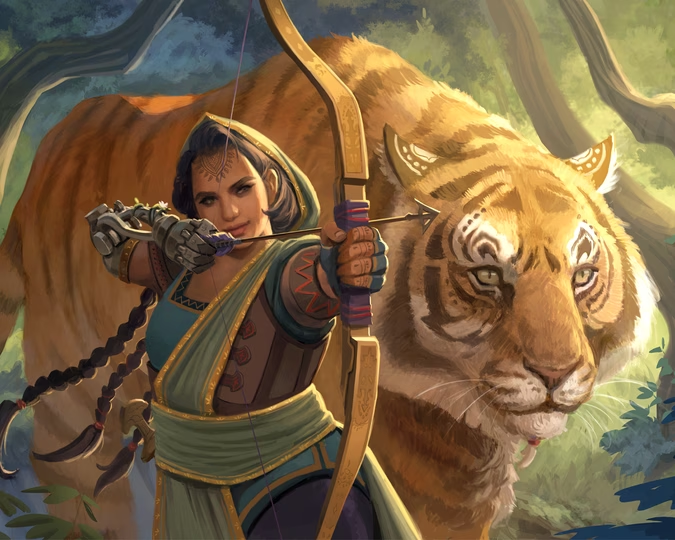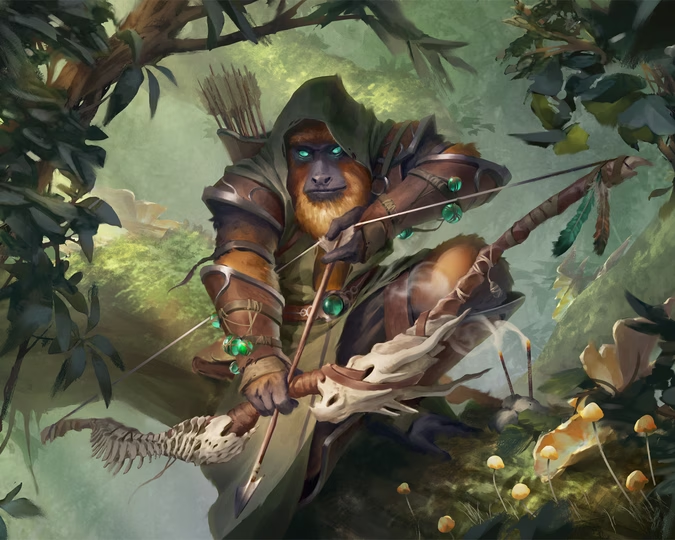Rangers are highly skilled hunters who, despite their martial abilities, rarely lend their skills to an army. Through mastery of the body and a deep understanding of the wilderness, rangers become sly tacticians, pursuing their quarry with cunning and patience. Many rangers track and fight alongside an animal companion with whom they’ve forged a powerful spiritual bond. By honing their skills in the wild, rangers become expert trackers, as likely to ensnare their foes in a trap as they are to assail them head-on.
Play the Beastbound if you want to form a deep bond with an animal ally.
Spellcast Trait
Foundation Features
Companion
You have an animal companion of your choice (at the GM’s discretion). They stay by your side unless you tell them otherwise.
Take the Ranger Companion sheet. When you level up your character, choose a level-up option for your companion from this sheet as well.
Specialization Features
Expert Training
Choose an additional level-up option for your companion.
Battle-Bonded
When an adversary attacks you while they’re within your companion’s Melee range, you gain a +2 bonus to your Evasion against the attack.
Mastery Features
Advanced Training
Choose two additional level-up options for your companion.
Loyal Friend
Once per long rest, when the damage from an attack would mark your companion’s last Stress or your last Hit Point and you’re within Close range of each other, you or your companion can rush to the other’s side and take that damage instead.
Ranger Companion
When you choose the Beastbound Ranger subclass, take a companion sheet. This sheet is for tracking important information about your character’s companion and can be tucked beneath the right side of your character sheet for ease of viewing.
Step 1: Name Your Companion
Work with the GM to decide what kind of animal you have as your companion. Give them a name and add a picture of them to the companion sheet.
Step 2: Write Their Evasion
Fill in their Evasion, which starts at 10.
Step 3: Choose Their Companion Experience
Create two Experiences for your companion based on their training and the history you have together. Start with +2 in both Experiences. Whenever you gain a new Experience, your companion also gains one. All new Experiences start at +2.
Example Companion Experiences
Bold Distraction, Expert Climber, Fetch, Friendly, Guardian of the Forest, Horrifying, Intimidating, Loyal Until the End, Navigation, Nimble, Nobody Left Behind, On High Alert, Protective, Royal Companion, Scout, Service Animal, Trusted Mount, Vigilant, We Always Find Them, You Can’t Hit What You Can’t Find
Step 4: Choose Their Attack and Record Damage Die
Finally, describe your companion’s method of dealing damage (their standard attack) and record it in the “Attack & Damage” section. At level 1, your companion’s damage die is a d6 and their range is Melee. Choose whether they deal physical or magic damage.
Working With Your Companion
The following sections will run you through the basics of working with your companion.
Using Spellcast Rolls, Hope, and Experiences
Make a Spellcast Roll to connect with your companion and command them to take action. Spend a Hope to add an applicable Companion Experience to the roll. On a success with Hope, if your next action builds on their success, you gain advantage on the roll.
Attacking With Your Companion
When you command your companion to attack, they gain any benefits that would normally only apply to you (such as the effects of “Ranger’s Focus”). On a success, their damage roll uses your Proficiency and their damage die.
Taking Damage As Stress
When your companion would take any amount of damage, they mark a Stress. When they mark their last Stress, they drop out of the scene (by hiding, fleeing, or a similar action). They remain unavailable until the start of your next long rest, where they return with 1 Stress cleared.
When you choose a downtime move that clears Stress on yourself, your companion clears an equal number of Stress.
Leveling Up Your Companion
When your character levels up, choose one available option for your companion from the following list and mark it on your sheet.
- Intelligent: Your companion gains a permanent +1 bonus to a Companion Experience of your choice.
- Light in the Dark: Use this as an additional Hope slot your character can mark.
- Creature Comfort: Once per rest, when you take time during a quiet moment to give your companion love and attention, you can gain a Hope or you can both clear a Stress.
- Armored: When your companion takes damage, you can mark one of your Armor Slots instead of marking one of their Stress.
- Vicious: Increase your companion’s damage dice or range by one step (d6 to d8, Close to Far, etc.).
- Resilient: Your companion gains an additional Stress slot.
- Bonded: When you mark your last Hit Point, your companion rushes to your side to comfort you. Roll a number of d6s equal to the unmarked Stress slots they have and mark them. If any roll a 6, your companion helps you up. Clear your last Hit Point and return to the scene.
- Aware: Your companion gains a permanent +2 bonus to their Evasion.
Companion List
Work with the GM to decide what kind of animal you have as your companion. Give them a name and draw or attach a picture of them in the space above. Then create two Experiences for your companion based on their training and the history you have together. Finally, describe their method of dealing damage (their standard attack) and record it in the “Attack & Damage” section. Their damage starts at d6 and their range starts at Melee.
Evasion
Your companion’s Evasion starts at 10.
Companion Experience
Start with +2 in both Experiences. Whenever you gain a new Experience, your companion also gains one. All new Experiences start at +2.
Example Companion Experiences
Bold Distraction, Expert Climber, Fetch, Friendly, Guardian of the Forest, Horrifying, Intimidating, Loyal Until the End, Navigation, Nimble, Nobody Left Behind, On High Alert, Protective, Royal Companion, Scout, Service Animal, Trusted Mount, Vigilant, We Always Find Them, You Can’t Hit What You Can’t Find
Make a Spellcast Roll to connect with your companion and command them to take action. Spend a Hope to add an applicable Companion Experience to the roll. On a success with Hope, if your next action builds on their success, you gain advantage on the roll.
Attack & Damage
Standard Attack: _______________ | Range: ________________
[ ] d6 | [ ] d8 | [ ] d10 | [ ] d12
When you command your companion to attack, they gain any benefits that would normally only apply to you (such as the effects of “Ranger’s Focus”). On a success, their damage roll uses your Proficiency and their damage die.
Stress
Stress: [x] [x] [x] [ ] [ ] [ ]
Your companion’s Stress Slots start at 3.
When your companion would take any amount of damage, they mark a Stress. When they mark their last Stress, they drop out of the scene (by hiding, fleeing, or a similar action). They remain unavailable until the start of your next long rest, where they return with 1 Stress cleared.
When you choose a downtime move that clears Stress on yourself, your companion clears an equal number of Stress.
Training
Whenever your character levels up, also choose one option for your companion from the list below and mark it
Cards

Jenny Tan
Core
Beastbound
Foundation
Spellcast: Agility
Companion: You have an animal companion of your choice (at the GM’s discretion). They stay by your side unless you tell them otherwise.
Take the Ranger Companion sheet. When you level up your character, choose a level-up option for your companion from this sheet as well.

Ranger

Jenny Tan
Core
Beastbound
Specialization
Expert Training: Choose an additional level-up option for your companion.
Battle-Bonded: When an adversary attacks you while they’re within your companion’s Melee range, you gain a +2 bonus to your Evasion against the attack.

Ranger

Jenny Tan
Core
Beastbound
Mastery
Advanced Training: Choose two additional level-up options for your companion.
Loyal Friend: Once per long rest, when the damage from an attack would mark your companion’s last Stress or your last Hit Point and you’re within Close range of each other, you or your companion can rush to the other’s side and take that damage instead.

Ranger
Play the Wayfinder if you want to hunt your prey and strike with deadly force.
Spellcast Trait
Foundation Features
Path Forward
When you’re traveling to a place you’ve previously visited or you carry an object that has been at the location before, you can identify the shortest, most direct path to your destination.
Specialization Features
Elusive Predator
When your Focus makes an attack against you, you gain a +2 bonus to your Evasion against the attack.
Mastery Features
Apex Predator
Before you make an attack roll against your Focus, you can spend a Hope. On a successful attack, you remove a Fear from the GM’s Fear pool.
Cards

Simon Pape
Core
Wayfinder
Foundation
Spellcast: Agility
Ruthless Predator: When you make a damage roll, you can mark a Stress to gain a +1 bonus to your Proficiency. Additionally, when you deal Severe damage to an adversary, they must mark a Stress.
Path Forward: When you’re traveling to a place you’ve previously visited or you carry an object that has been at the location before, you can identify the shortest, most direct path to your destination.

Ranger

Simon Pape
Core
Wayfinder
Specialization
Elusive Predator: When your Focus makes an attack against you, you gain a +2 bonus to your Evasion against the attack.

Ranger

Simon Pape
Core
Wayfinder
Mastery
Apex Predator: Before you make an attack roll against your Focus, you can spend a Hope. On a successful attack, you remove a Fear from the GM’s Fear pool.

Ranger






Comments
There are no comments yet